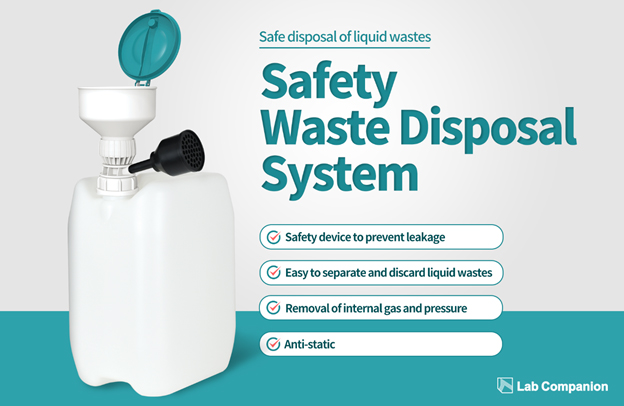|
Greetings! At JEIO TECH Lab Companion, we understand the importance of proper chemical waste management in laboratory safety. As required by regulations, all users must adhere to the correct disposal procedures and waste management while operating a chamber with precise temperature control. In this blog, we will explore the options for the proper disposal of chemical waste. We categorized chemical waste from A to L and proposed appropriate treatments for each.
Inorganic waste
A. Free Cyanide
1. Neutralization can be achieved by introducing a chemical, such as sodium hydroxide (NaOH), which reacts with the cyanide to form a less toxic compound.
2. Adsorption onto solid materials, such as activated carbon, is another method for removing free cyanide from the solution.
3. Free cyanide waste can be oxidized to form less toxic compounds, such as carbon dioxide and nitrogen gas.
B. Mercuric
1. Collection: Mercuric waste such as inorganic mercury and alkylmercury should be collected in leak-proof, labeled containers and stored in a secure area to prevent releases and leaks. Wastewater washed at least three times should be collected separately.
2. Segregation: Mercuric waste should be segregated from other waste materials to prevent contamination.
C. Fluorine, Phosphoric: e.g., hydrogen fluoride, phosphoric acid, wastewater washed at least three times
D. Acid, Chromic acid: e.g., Inorganic acid (hydrochloric acid, sulfuric acid, nitric acid), Mixed liquor (chromic acid & sulfuric acid)
E. Alkalic
Neutralization: Above waste can be neutralized by adding chemical compounds to form less hazardous compounds. The selection of the appropriate chemicals for this purpose will depend on the type of waste being treated. Sodium hydroxide (NaOH) is a common chemical used for acid. Alkaline waste can be neutralized by an acid such as sulfuric acid (H2SO4) and hydrochloric acid (HCl).
F. Metallic
1. Recycling metallic waste can provide numerous environmental benefits, such as reducing the need for raw materials and preventing pollution. This process involves collecting scrap metal, separating it into different types, and then processing it to create new products.
2. Smelting can be used to refine the waste into new products. This process involves heating the waste to high temperatures to remove impurities and then casting it into the desired form.
G. Photographic
1. Biological treatment is an effective method for treating photographic wastewater. Microorganisms are added to the waste, which helps to break down hazardous chemicals into less harmful substances.
2. Reverse osmosis can be utilized to reduce the presence of hazardous chemicals. This process uses pressure to force the water through a membrane, effectively removing the chemicals.
Organic waste
H. Hydrocarbon (flammable): e.g., Aliphatic compounds (hexane, pentene, alcohol, acetone, triethylamine) and Aromatic compounds (benzene, toluene, pyridine)
1. Recovery: Hydrocarbon waste can be recovered and reutilized through collection, refinement, and subsequent reuse as fuel or as raw material for other products.
2. Incineration: This is a commonly used method for disposing of hydrocarbon waste that is too contaminated or hazardous to be recovered. By burning the waste at high temperatures, it can be safely and effectively destroyed, while also reducing its volume and the number of pollutants released into the environment.
I. Waste oil (flammable): e.g., lamp oil, diesel, Turpentine Oil lubricant, grease, animal and vegetable oils
J. Halogenated waste solvent (flammable): e.g., Aliphatic compounds (chloroform, dichloromethane, carbon tetrachloride) and Aromatic compounds (chlorobenzene, chlorinated benzene)
K. Fire retardant organic waste: e.g., water-mixed waste liquid containing organic solvents, water-mixed waste liquid containing 5% or more of organic acids and amino acids, aqueous waste fluid of other organic compounds, highly decomposable cyanide, organic cyanide compound
L. Tangible solid waste: e.g., stained gloves
1. Recycling: Above waste can be recycled and reused as fuel, solvent, or raw material to produce other products.
2. Incineration is a cost-effective and efficient method for reducing the volume of hazardous and contaminated waste. During the process, the waste is burned at high temperatures, reducing its volume, and destroying the waste, while producing minimal environmental impact
It is essential to consider the type, quantity, and form of chemical waste when determining the appropriate method of treatment and disposal. Professional hazardous waste management companies should be consulted for guidance. Following these guidelines will ensure the safe use of the product, maintenance of the experimental equipment, and disposal of chemical waste.
Lab Companion recommends utilizing a “Safety Waste Disposal System” to ensure the safe storage of chemical waste.

For more information on this system, please click the link provided.
Go to Link
Proper chemical waste disposal practices are essential for the safe research environments.
JEIO TECH is committed to improving such safety through its Lab Companion products.
To ensure this, we continually listen to and reflect on customer feedback.
Thank you for your ongoing support.
|



